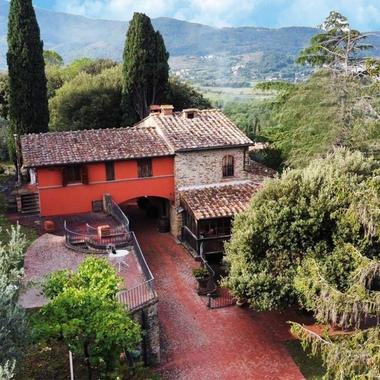Descrizione
Estate consisting of a magnificent villa built in Renaissance style in the second half of the 17th century, two farm buildings, a granary, a lemon house, a woodshed and a church with a private frescoed chapel for sale in Santa Croce sull'Arno.
The property has a total surface area of approximately 4,500 sqm.
The villa, the central body of the estate, was built on a pre-existing tower on the initiative of Domenico Guerrini, evidence of which remains in the heraldic coat of arms placed at the top of the entrance.
Marquise Maria Ottavia Vettori Placidi made it a meeting place for artists and men of letters. It is no coincidence that the Macchiaioli painter Cristiano Banti, a native of Santa Croce sull'Arno, who had found an important patron in the marchioness, stayed here.
The villa is arranged on three floors and shows particular care in the furnishings.
The ground floor is occupied by a large living room with a pietra serena fireplace and two adjoining rooms: the first is a very refined study, carved out of a chapel, while the second is a sitting room connected to a bathroom. The ante-bathroom, adorned with a tapestry with oriental motifs, is beautifully detailed.
The main floor, accessed by two flights of barrel-vaulted pietra serena stairs, is truly splendid. The main hall, complete with a small balcony overlooking the valley and from which the towers of San Mianiato can be glimpsed, has its walls entirely frescoed with trompe-l'oeil paintings depicting the surrounding landscape. The effect of dematerialisation of the walls is very suggestive and is repeated in what is probably the most curious room of the villa. The salon leads, in fact, to the presumed room of Cristiano Banti, who probably intervened in its pictorial decoration.
The estate's park is very large and includes gardens and orchards, an English garden, a natural lake, vineyards and olive groves, totalling 45 hectares.
The Italian-style garden at the back of the villa, which can best be admired from the upper floors, is the most striking feature.
Passing through a small door hidden by plants and walking along the outer circuit of the wall, adorned with an ancient boxwood hedge, we reach a 'labyrinth'. The path, winding through a forest of holm oaks, is bordered by low laurel hedges and leads to the 'hermit's cave', St Benigno, protector of young women of marriageable age, whose remains are preserved in the villa's small church.







































